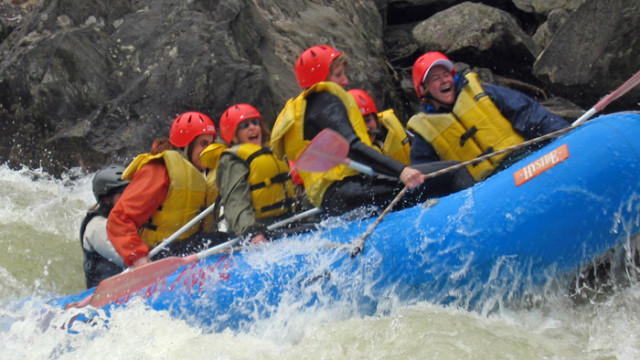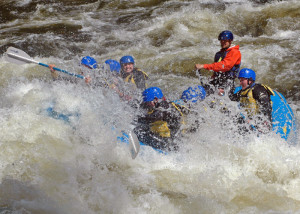
Whitewater rafting is something every Active Outdoors enthusiast should try at some point, and Spring is the perfect time. So is Summer, or, for that matter, Fall. As long as the water is flowing, it’s a good time for rafting, as our correspondents have discovered when they went rafting on the Concord River in Massachusetts, the Androscoggin River in New Hampshire, the Penobscot River in Maine, The Deerfield River in Massachusetts, the Hudson River in New York and elsewhere. Don’t let the cold water scare you. You’ll be wearing a wetsuit and a paddling jacket if it’s cold.
Spring, Summer or Fall, whitewater rafting is pure sensory overload, a wild rollercoaster ride with smiles guaranteed. It doesn’t matter whether you are on the Kennebec River in Maine, the Hudson, the Deerfield in Massachusetts, the Androscoggin or Winnipesaukee in New Hampshire, or any other flowing river. The experience is going to be memorable.
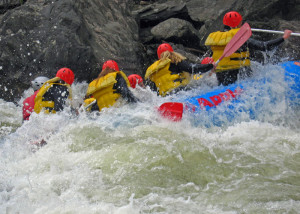
Even if you’ve been rafting before, the experience on every river is slightly different. On Maine’s Kennebec, for example, you start fast. The second you push away from the bank, the current grabs you and you go plunging into Class II and IV rapids (the higher the number, the higher the waves, the more exciting the ride.) On my first rafting trip, within seconds, everyone in our raft was laughing and shrieking for the sheer joy of it—and the ride hadn’t really started yet. The first five miles were pure rollercoaster; the last seven miles, pure relaxation.
On the Deerfield in western Massachusetts, you start and finish slowly and get your wild ride in the middle on a number of Class II-III rapids, with one very exciting Class IV moment at Zoar Gap. This is an excellent trip for first-timers, scary-fun but not overwhelming. .
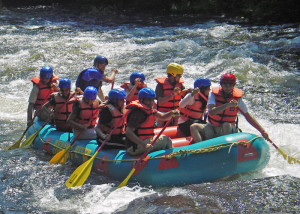
The Hudson River starts quickly with a trip down the Indian River to join the Hudson. Then it’s in and out of Class III and IV rapids most of the way, with quiet pockets between to relax and re-group (and maybe take a swim alongside the floating raft!). Great ride!
Because of liability insurance concerns, there are typically age and size restrictions on who can go rafting. Check ahead of time if you want to bring very small children – your options may be limited. Other than that, rafting is an adventure that a whole family from kids to healthy, mobile great-grandparents can share and enjoy together.
Even non-swimmers are welcome on most rafting expeditions. For safety’s sake, you’re wearing a helmet and a heavy-duty PFD (Personal Flotation Device) at all times while you’re in or on the river.
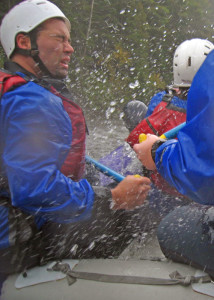
Some rafting aficionados focus on “big-water releases” and small rafts. Big water rafting in a small raft is rafting taken to it’s logical conclusion—bigger waves, faster water, and a smaller boat that bounces around more. Fun! Because you need one guide for each raft and the smaller raft has fewer people, you pay a little extra to be in the small raft, and a little more for coveted “Big Water” release days (when hydro dams are opened fully to test the turbines). But if you’ve already tried rafting, are ready for a bigger thrill, but not yet ready to do it on your own in a kayak or canoe, this is the way to go.
So don’t be timid. Relax and go with the flow.
A Raft of Options:
Here’s a (probably incomplete) list of rafting options around New England, New York and Pennsylvania. Any of these companies who have stayed in business any length of time know what they are doing. There’s too much competition for the weak to survive. My advice: Look over the websites, call and ask lots and lots of questions about what’s included in the price, and then book with the one that seems best for you.
Whitewater Rafting in Maine
(Dead, Kennebec, and Penobscot Rivers)
Whitewater Rafting in New Hampshire and Maine
(Androscoggin, Magalloway, Rapid Rivers)

(Winnipesaukee River)
Whitewater Rafting in Massachusetts and Vermont
(Concord, Deerfield and West Rivers)
Whitewater Rafting in New York
(Hudson, Sacandaga, Black, Salmon, and Moose Rivers)

Adventure Sports Rafting Company
Whitewater Rafting in Pennsylvania
What To Bring Whitewater Rafting
Proper dress for whitewater rafting includes a bathing suit or river shorts that will stay on. That’s all you need in warm weather. If the water’s cold, you’ll wear these under a wetsuit the rafting company will provide. If you have your own wetsuit or dry suit, by all means bring it.
Footwear: Sneakers you don’t mind getting wet are OK, but river sandals or neoprene booties are better. The rafting company will often provide neoprene booties in cold weather. Wool or polypro socks will help keep your feet warm.
On the water, you’ll want cheap sunglasses (in case you lose them) with a retainer. Waterproof sunblock and a brimmed hat are nice if the sun is shining. You spend a lot of time out in the sun at mid-day while rafting.
In spring and summer, blackflies and mosquitoes can be a problem—waterproof insect repellent is a good idea.
By all means bring a waterproof camera. If you don’t have one, buy a waterproof case for your smart phone or point-and-shoot at any good camera shop.


